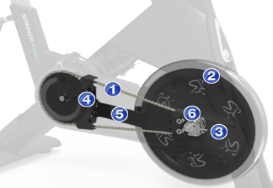Chain Drive and Flywheel Replacement
(Chain drive bikes only).
About
This procedure provides instruction to remove and install the Chain Drive and Flywheel.
Chain replacement requires removal of the flywheel so this procedure provides instructions for both chain and flywheel replacement.
|
|
WARNING: Personal injury is possible while removing/installing the flywheel. The flywheel weighs approximately 43 lbs (19.5 kgs) and can pinch or fall onto fingers or other extremities causing personal injury. |
|
|
|
Specifications
| System Component | Specification |
|---|---|
| Chain Drive Tension | 1/2 in (1.3 cm) up/dwn travel |
| Axle Nut TorqueTorque is a measure of the force that can cause an object to rotate about an axis. Bolt/nut example: 5 nM torque is equivalent to 5 newtons of force applied one meter from the center of the bolt, 6 ft-lb is equivalent to 6 lb of force applied 1 foot away from the center of the bolt. | 29.5 ft-lbs (40 Nm) |
Procedure
Review entire procedure before starting.
Removal instructions
- Remove front and rear chain guards, see Belt/Chain Guard Cover Replacement.
- Remove all brake pad resistance by turning the resistance knob counter clockwise (-).
- Remove the rear chain sprocket finger guard
 by removing the fasteners (2x) using a 5 mm hex key. Retain part(s) and/or fastener(s) for installation.
by removing the fasteners (2x) using a 5 mm hex key. Retain part(s) and/or fastener(s) for installation. - Loosen, but do not remove, the left and right axle nuts
 using a 19 mm wrench to allow axle movement.
using a 19 mm wrench to allow axle movement. - Remove chain tension by alternately loosening the left and right chain adjustment nuts
 using a 10 mm wrench. Remove nuts. Retain part(s) and/or fastener(s) for installation.
using a 10 mm wrench. Remove nuts. Retain part(s) and/or fastener(s) for installation. - Remove the frame cross member
 by removing the two front and two rear bolts, washers, and nuts using a 6 mm hex key. Grasp the cross member to prevent falling during removal. Retain part(s) and/or fastener(s) for installation.
by removing the two front and two rear bolts, washers, and nuts using a 6 mm hex key. Grasp the cross member to prevent falling during removal. Retain part(s) and/or fastener(s) for installation. - Remove the flywheel using two service techs to carefully slide the flywheel rearward off the frame.

|
|
NOTE: Make sure there is no brake pad resistance applied to the flywheel. |
- Remove the chain by carefully removing the chain off the front sprocket and then sliding the chain over the rear crank arm and pedals.
- Place the chain over the pedals and rest it on the crank arm, do not put the chain onto the sprocket teeth.
- Place the other end of the chain onto the flywheel axle sprocket teeth.
- Reinstall the flywheel using two service techs to carefully slide the flywheel into the frame axle bracket. The chain adjustment bolts need to slide thru the adjustment nut bracket holes.
Installation Instructions.
|
|
TIP: You may find it easier to stand the bike frame on its front (resting on the front stabilizer and handlebar) and then installing the flywheel into the axle mounting slots. The weight of the flywheel will help to slide the flywheel into the mounting slots. Carefully hold the flywheel and return bike to the upright position. |
- Reinstall the frame cross member
 using the two front and two rear bolts, and washers using a 6 mm hex key.
using the two front and two rear bolts, and washers using a 6 mm hex key. - Thread the left/right chain tension adjustment nuts
 onto the adjustment bolt but do not tighten. Pull the flywheel forward until the chain tension stops movement. Then align the flywheel angle so that the front of the flywheel rim is equally spaced and centered within the frame forks. Then tighten the tensioner nuts until snug.
onto the adjustment bolt but do not tighten. Pull the flywheel forward until the chain tension stops movement. Then align the flywheel angle so that the front of the flywheel rim is equally spaced and centered within the frame forks. Then tighten the tensioner nuts until snug. - Adjust the chain tension to specification, go to Chain Drive Tension Adjustment
- Tighten the left and right axle nuts
 , torque to 29.5 ft-lbs (40 Nm).
, torque to 29.5 ft-lbs (40 Nm). - Reinstall the rear chain sprocket finger guard
 , secure with two fasteners using a 5 mm hex key.
, secure with two fasteners using a 5 mm hex key. - Replace front and rear chain guard covers in reverse order, see Belt/Chain Guard Cover Replacement.
- Verify that the brake pad is centered on the flywheel and operating correctly.
- Verify the bike operation per Operation Verification Checklist and return to service.
.See Also
